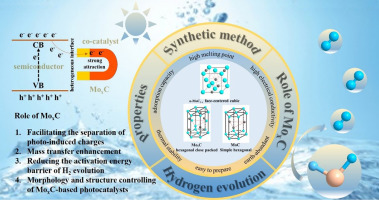当前位置:
X-MOL 学术
›
Adv. Colloid Interface Sci.
›
论文详情
Our official English website, www.x-mol.net, welcomes your feedback! (Note: you will need to create a separate account there.)
Sustainable hydrogen production by molybdenum carbide-based efficient photocatalysts: From properties to mechanism.
Advances in Colloid and Interface Science ( IF 15.6 ) Pub Date : 2020-03-19 , DOI: 10.1016/j.cis.2020.102144 Yin Zhou 1 , Wenjun Wang 1 , Chen Zhang 1 , Danlian Huang 1 , Cui Lai 1 , Min Cheng 1 , Lei Qin 1 , Yang Yang 1 , Chengyun Zhou 1 , Bisheng Li 1 , Hanzhuo Luo 1 , Donghui He 1
Advances in Colloid and Interface Science ( IF 15.6 ) Pub Date : 2020-03-19 , DOI: 10.1016/j.cis.2020.102144 Yin Zhou 1 , Wenjun Wang 1 , Chen Zhang 1 , Danlian Huang 1 , Cui Lai 1 , Min Cheng 1 , Lei Qin 1 , Yang Yang 1 , Chengyun Zhou 1 , Bisheng Li 1 , Hanzhuo Luo 1 , Donghui He 1
Affiliation

|
Hydrogen is considered to be a promising energy carrier to solve the issue of energy crisis. Molybdenum carbide (MoxC) is the typical material, which has similar properties of Pt and thought to be an attractive alternative to noble metals for H2 evolution. The study of MoxC as alternative catalyst for H2 production is almost focused on electrocatalytic field, while the application of MoxC as a co-catalyst in photocatalytic H2 evolution has received in-depth research in recent years. Particularly, MoxC exhibits significant enhancement in the H2 production performance of semiconductors under visible light irradiation. However, a review discussing MoxC serving as a co-catalysts in the photocatalytic H2 evolution is still absent. Herein, the recent progress of MoxC on photocatalytic H2 evolution is reviewed. Firstly, the preparation methods including chemical vapor deposition, temperature programming, and organic-inorganic hybridization are detailly summarized. Then, the fundamental structure, electronic properties, and specific conductance of MoxC are illustrated to illuminate the advantages of MoxC as a co-catalyst for H2 evolution. Furthermore, the different heterojunctions formed between MoxC and other semiconductors for enhancing the photocatalytic performance are emphasized. Finally, perspectives regarding the current challenges and the future research directions on the improvement of catalytic performance of MoxC-based photocatalysts are also presented.
中文翻译:

碳化钼基高效光催化剂可持续制氢:从性能到机理。
氢被认为是解决能源危机问题的有希望的能源载体。碳化钼(MoxC)是典型的材料,它具有与Pt相似的特性,并且被认为是用于释放H2的有吸引力的金属替代品。MoxC作为制氢的替代催化剂的研究几乎集中在电催化领域,而MoxC作为助催化剂在光催化制氢方面的应用近年来受到了深入的研究。特别地,MoxC在可见光照射下在半导体的H2生产性能方面显示出显着的提高。然而,关于MoxC在光催化H2演变过程中作为助催化剂的讨论仍然缺乏。在本文中,综述了MoxC在光催化H2释放方面的最新进展。首先,详细总结了化学气相沉积,程序升温,有机-无机杂化等制备方法。然后,说明了MoxC的基本结构,电子性质和比电导,以阐明MoxC作为H2析出的助催化剂的优势。此外,强调了在MoxC和其他半导体之间形成的用于增强光催化性能的不同异质结。最后,还提出了有关当前挑战以及改进MoxC基光催化剂催化性能的未来研究方向的观点。并说明了MoxC的比电导,以阐明MoxC作为H2析出的助催化剂的优势。此外,强调了在MoxC和其他半导体之间形成的用于增强光催化性能的不同异质结。最后,还提出了有关当前挑战以及改进MoxC基光催化剂催化性能的未来研究方向的观点。并说明了MoxC的比电导,以阐明MoxC作为H2析出的助催化剂的优势。此外,强调了在MoxC和其他半导体之间形成的用于增强光催化性能的不同异质结。最后,还提出了有关当前挑战以及改进MoxC基光催化剂催化性能的未来研究方向的观点。
更新日期:2020-03-20
中文翻译:

碳化钼基高效光催化剂可持续制氢:从性能到机理。
氢被认为是解决能源危机问题的有希望的能源载体。碳化钼(MoxC)是典型的材料,它具有与Pt相似的特性,并且被认为是用于释放H2的有吸引力的金属替代品。MoxC作为制氢的替代催化剂的研究几乎集中在电催化领域,而MoxC作为助催化剂在光催化制氢方面的应用近年来受到了深入的研究。特别地,MoxC在可见光照射下在半导体的H2生产性能方面显示出显着的提高。然而,关于MoxC在光催化H2演变过程中作为助催化剂的讨论仍然缺乏。在本文中,综述了MoxC在光催化H2释放方面的最新进展。首先,详细总结了化学气相沉积,程序升温,有机-无机杂化等制备方法。然后,说明了MoxC的基本结构,电子性质和比电导,以阐明MoxC作为H2析出的助催化剂的优势。此外,强调了在MoxC和其他半导体之间形成的用于增强光催化性能的不同异质结。最后,还提出了有关当前挑战以及改进MoxC基光催化剂催化性能的未来研究方向的观点。并说明了MoxC的比电导,以阐明MoxC作为H2析出的助催化剂的优势。此外,强调了在MoxC和其他半导体之间形成的用于增强光催化性能的不同异质结。最后,还提出了有关当前挑战以及改进MoxC基光催化剂催化性能的未来研究方向的观点。并说明了MoxC的比电导,以阐明MoxC作为H2析出的助催化剂的优势。此外,强调了在MoxC和其他半导体之间形成的用于增强光催化性能的不同异质结。最后,还提出了有关当前挑战以及改进MoxC基光催化剂催化性能的未来研究方向的观点。


























 京公网安备 11010802027423号
京公网安备 11010802027423号